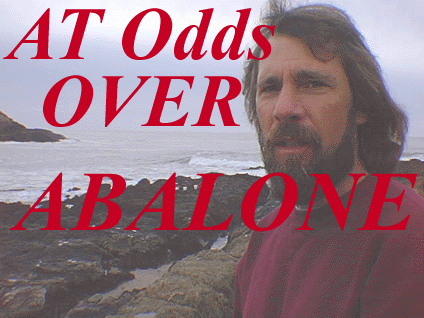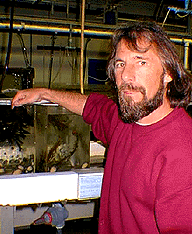 Government, Sportsmen, Experts Wrangle Over Management of Popular Mollusk philip e daoust |
||
| They are a delicacy of the sea, abundant in some areas along the California coast and nearly extinct in others. They bring in huge profits for commercial fisheries and are increasingly in demand by consumers around the world. | ||
| But the days of the abalone gold rush may be coming to an end. In recent years, environmentalists, marine biologists, commercial abalone divers, sport abalone divers and state officials have been engaged in a steadily escalating feud about the future of this valuable species. | ||
| Critics charge officials of the California Department of Fish and Game of failing to protect declining abalone populations in the state's coastal waters, most notably in offshore regions south of San Francisco to the border with Mexico. | ||
| "Because of the system being used in managing marine resources, and especially abalone, it has caused the destruction of the resource," said Paul Turnbull, director of the Abalone and Marine Resources Council. His group is calling for a ban on the commercial harvesting along the entire California coast. | ||
| At the Dec. 5, 1996 meeting of the CDFG in Eureka, commissioners postponed further discussion of abalone harvesting until February 1997. During January, February, and August commercial diving is not allowed. | ||
| Sustained Yield Sought | ||
| Turnbull, whose group represents sports divers, said his group is calling for a management program that would set quotas to achieve a "sustained yield." |  |
|
| "This is a case where we have very specific requirements which have been utterly ignored because of political interference and money people have been making," Turnbull said. He called CDFG's response to the situation "taking action after the patient has died." | ||
| Turnbull said that the CDFG is required by law to take action to maintain the species. | ||
| In January of 1996, CDFG banned the taking of three species of abalone-- white, green and pink--because each species' numbers had plummeted to the brink of extinction. Black abalone were banned in 1993. | ||
| In fact, CDFG's own numbers show that abalone populations have dropped significantly in recent years. | ||
| According to Konstantin Karpov, an associate marine biologist for CDFG in Fort Bragg, both pink and green abalone now number less than 1 percent of their historical average. Red abalone, the only abalone specie allowed to be harvested commercially, represent only 13 percent. | ||
| "None of those species is found in appreciative numbers south of Half Moon Bay," said John Duffy, a marine biologist with CDFG in Sacramento. Over the last 20 years he said that abalone have declined from "millions of pounds to thousands each year." | ||
| Indeed, during the 1950s, the annual harvest averaged nearly five million pounds, compared to approximately 260,000 pounds in 1995. Currently, commercial divers can take 84 red abalone a day from the San Mateo coast to Pillar Point. South of there to the San Diego area, the limit is 130 a day. | ||
| Some Want Commercial Ban | ||
 |
Some abalone experts are calling on CDFG to close all commercial abalone taking, including the red abalone. "The commercial ab fishery should be closed until the species shows signs of recovery," said Will Borgeson, an aquaculturist with the University of California, Davis, stationed at UC's marine lab in Bodega Bay. He said he was speaking for himself, not the university. | |
| "There are hardly any abalone left in waters where the commercial fishery exists," Borgeson said. | ||
| Turnbull accuses CDFG of allowing the red abalone to slowly die off before taking action, as he says it did with the other abalone species. The reason for the slowness, he said, was the "big money" being made because the demand for abalone is so high, especially in China and Japan. | ||
| But some commercial divers say that groups like the AMRC have misrepresented the degree to which the red abalone have declined by lumping it in with the overall declines of the species that have been closed. | ||
| "They have taken the green, pink and white declines and diluted the red fishery data and said that there is overall decline and we need to close the red fishery also," said Mike Kitahara, president of the California Abalone Association. | ||
| Restrictions imposed by the state, and misinformation about commercial divers from groups like AMRC, have hurt his industry, Kitahara said. | ||
| "It's pretty hard to get anything done when people think that you are just an outlaw," Kitahara said. | ||
| Turnbull wants the formation of a CDFG subcommittee to regulate commercial and sport abalone harvesting. He wants the state legislature to require the formation of the subcommittee, consisting of at least five biologists. | ||
| Turnbull claims both the United Anglers Association and the Catalina Divers Association are backing AMRC's proposal. But he said no legislator in Sacramento backs it. | ||
| Some Want CDFG Replaced | ||
| Some experts would like to see the CDFG eliminated and replaced by a new agency. | ||
| "While there are numerous good individuals in the agency," said Borgeson, "many people who work in the marine sciences in California have little respect for CDFG as a whole, because it has such a dismal track record with fisheries management. On its watch, many of our valuable fisheries have been decimated." | ||
| Borgeson said that the "good ol' boy network" is so well entrenched in the politics and policy making of CDFG that it won't change any time soon, and that often the agency doesn't pay much attention to the findings of its own biologists. | ||
| "Usually, the tune seems to be called by the major harvesters, processors and sport interests," he said. "The Department is very responsive to the needs and desires of the fishing industry." He said it was less responsive to the needs of the marine life it is supposed to protect. | ||
| All sides in the abalone debate agree, however, on one thing: that the species is not threatened on the northern California coast at this time. | ||
| Commercial abalone diving is illegal north of San Francisco to the Oregon border. But sport divers, without the use of scuba equipment, can take up to four abalone a day for seven months of the year: from April through June and August through November. | ||
| Others Want North Coast Commercial Harvest |  |
|
| Some argue that North Coast harvesting should not be open to sport divers while off limits to commercial divers. | ||
| "The attorney general's office," Kitahara said, "reviewed the statues and determined that fish & game has no authority to close commercial fishery without closing sport fishery." | ||
| But Borgeson warned against allowing CDFG to open the North Coast to commercial interests. | ||
| "It's a terrible idea," he said. "The agency has allowed the Southern California abalone populations to be tragically over-exploited. The catch record is crystal clear; there are hardly any abs left down there, yet CDFG lets the harvesting go on. The North Coast abalone fishery is too valuable, in too many ways, to allow that to happen up here too." | ||
| He also said that northern California sport diving limits should be cut from four abalone per diver per day to two, and that the sport abalone fishery in the south should either be closed along with the commercial fishery, or changed to a "breath-hold" fishery as in the north. Currently in the south Scuba gear is allowed. "Divers on Scuba and hookah rigs may well be taking, eating and selling the last hope for the Southern California abalone population's recovery," Borgeson said. | ||
| Poaching Problem | ||
| There is at least one problem that concerns everyone: abalone poaching. | ||
| Said Turnbull: "People don't realize how much poaching is going on along the North Coast. They are nickel and diming the North Coast to death." There is no evidence to back this claim, however, since no study has been done. | ||
| A source wishing to remain unidentified said it is likely that some commercial divers venture into the North Coast waters at night to take abalone, then later claim the abalone came from legal zones south of San Francisco. | ||
| But Kitahara is skeptical that commercial divers are poaching. He said that he personally knows most of the commercial divers who sport dive on the North Coast. | ||
| "If they saw one of their colleagues involved ... they would turn them in," he said. "We are also kept under a high degree of surveillance when we are working." | ||
| He believes that poaching is most likely being committed by sport divers, spurred by the high demand for the fishery. He said that once the sports season opens, the bottom goes out of the commercial market. | ||
| But catching and prosecuting poachers is difficult, according to Duffy, because the CDFG lacks the required manpower and resources to catch poachers. | ||
| Live abalone in the shell sell for about $10 a pound on the wholesale market; farm-raised abalone, live and in the shell, sell for about $22 a pound wholesale; and on the black market abalone sell for about $5 a pound. From 1982 to 1995, there was a three-fold increase in the value of abalone in California, Karpov said. | ||
| Over the past year, a number of abalone poachers were arrested and sentenced to prison following a three-year investigation by former Sonoma County game warden David Bezzone. | ||
| In the end, 17 men and women were convicted--three went to San Quentin prison--in what officials say is the largest felony poaching operation in the state's history. | ||
| To catch the poachers, Bezzone staked out abalone sites along the North Coast and secured the help of an informant. | ||
| As the facts unraveled, Bezzone discovered that the group took as many as 10,000 abalone worth about $1 million. The poaching operation was led by a San Diego fisherman and buyer named Van Howard Johnson, who sold the abalone to restaurants in southern California and shipped it to New York, China and Japan. | ||
| Bezzone, in an undercover operation, sold abalone to the China Garden restaurant in Santa Rosa and the Golden Dragon in Sebastapol. | ||
| Despite this and other recent, highly-publicized busts, Borgeson claims it is only the tip of the iceberg. "The real big boys don't get caught," he said. | ||
| Reasons for Decline | ||
| There are a number of theories about why abalone have declined so dramatically along the coast south of Half Moon Bay to the US-Mexican border. | ||
| The most obvious reason for the decline is four decades of heavy commercial harvesting. | ||
| "The incredible demand," Karpov said, "led to continued and elevated harvest pressure in spite of a declining area of stock." | ||
| Another reason for the decline, often cited by CDFG officials, is the re-emergence of sea otter populations in the coastal waters from Morro Bay north to Monterey Bay. Sea otters feed on abalone and remain in areas where they are plentiful. | ||
| But some observers do not agree that sea otters are a major cause. "The abalone was over-fished on the Central Coast prior to the re-emergence of the sea otters," Borgeson said. "Otters and abs coexisted in the aquatic web of life that functioned for millennia before humans came on the scene." | ||
| Furthermore, he said, the current range of the sea otter on the California coast is approximately 100 miles--not enough to impact abalone on a state-wide basis. | ||
| "It's a diversionary tactic to point to this small segment of coast and blame everything on the sea otter," Borgeson said. | ||
| "It's a diversionary tactic to point to this small segment of coast and blame everything on the sea otter," Borgeson said. "It's akin to pointing to the small populations of red abs that still exist in the Channel Islands, and saying that the Southern California stocks are in great shape." He drubbed this "industry propaganda." | ||
| Another reason for the decline may be a rare foot malady that biologists don't yet understand, Karpov said. | ||
| "A subset of the population did show signs of withering syndrome, but it more directly impacts black abalone," a specie that is hard to find nowadays, Karpov said. | ||
| Experts also say that pollution, human population increase, the meteorological phenomena of El Nino, private fishing boat tours and a rare South African worm may all be contributing to the decline. | ||
| Another cause of the decline, Turnbull said, is that abalone are often removed before they are fully mature. | ||
| Borgeson agrees. All along the coast, he said, there are beach goers who illegally remove "juvenile abalone" from the rocks for consumption. | ||
| Karpov said that legal abalone must be at least seven inches in diameter. Often, he said, smaller abalone are removed, interrupting the natural reproductive cycle. | ||
| On the other hand, abalone populations are thriving on the North Coast. Karpov said the reason may be the over-harvesting of North Coast sea urchins by commercial divers. | ||
| Abalone Farming | ||
| Chickens and pigs have been raised for hundreds of years on farms, so why not abalone? A recent trend is raising abalone on special "abalone farms." A number of new farming operations in California are undertaking the costly and high-risk venture of harvesting abalone in tanks, some in the ocean, others on land. | ||
| "There's an extremely large amount of capital that has to go into abalone farming," said Kitahara, who began an abalone farm last year. "You don't see profits for five or six years, but it pays off after that." | ||
| But Turnbull said that he is not in favor of tank-bred abalone because their introduction to the ocean may expose sea-bred abalone to pathogens and diseases they wouldn't normally encounter. | ||
| California Abalone, an operation in Tomales Bay, uses 50-gallon drums to raise abalone, Turnbull said. Sea kelp, which he claims has been declining along the coast for decades, is removed by workers to feed the abalone. | ||
| "We have a serious ecological problem just because of the so-called abalone raising," he said. | ||
| But Pete Kalvass, a marine biologist with CDFG, called the decline in kelp "arguable." Though there might be some "local impact" from removing it, he said the overall amount of kelp varies from year to year. | ||
| "I like the idea of abalone aquaculture," Borgeson said. "It is a thriving and growing industry in California and other places." He said it provides jobs and produces revenues without "hitting too heavily the natural fisheries." | ||
| "I like the idea of abalone aquaculture," Borgeson said. "It is a thriving and growing industry in California and other places." He said it provides jobs and produces revenues "without hitting too heavily the natural fisheries." | ||
| He also praise the product as "tender and flavorful." But he cautioned that enough varied brood stocks should be used to avoid inbreeding problems. | ||
 |